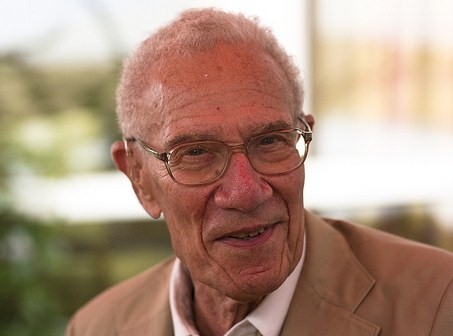
Robert Solow
Robert Merton Solow, GCIH (/ˈsoʊloʊ/; August 23, 1924 – December 21, 2023) was an American economist and Nobel laureate whose work on the theory of economic growth culminated in the exogenous growth model named after him.[28][29]
Robert Solow
December 21, 2023 (aged 99)
George Akerlof[1]
Mario Baldassarri[2]
Francis M. Bator[3]
Charlie Bean[4]
Alan Blinder[5]
Vittorio Corbo
Peter Diamond[6]
Avinash Dixit[7]
Mario Draghi
Alain Enthoven[8]
Ray Fair[9]
Ronald Findlay[10]
Robert J. Gordon[11]
Robert Hall[12]
Michael Intriligator[13]
Katsuhito Iwai[14]
Ronald W. Jones[15]
Arnold Kling
Meir Kohn
Glenn Loury[16]
Herbert Mohring[17]
William Nordhaus[18]
George Perry[19]
Robert Pindyck
Arjun Kumar Sengupta[20]
Steven Shavell[21]
Eytan Sheshinski[22]
Jeremy Siegel[23]
Joseph Stiglitz[24]
Harvey M. Wagner[25]
Martin Weitzman[26]
Halbert White[27]
He was Institute Professor Emeritus of Economics at the Massachusetts Institute of Technology, where he was a professor from 1949 on.[30] He was awarded the John Bates Clark Medal in 1961,[31] the Nobel Memorial Prize in Economic Sciences in 1987,[32] and the Presidential Medal of Freedom in 2014.[33] Four of his PhD students, George Akerlof, Joseph Stiglitz, Peter Diamond, and William Nordhaus, later received Nobel Memorial Prizes in Economic Sciences in their own right.[34][35][36] while an undergraduate student of Solow, H. Robert Horvitz, won in medicine.
Biography[edit]
Robert Solow was born in Brooklyn, New York, into a Jewish family on August 23, 1924, the oldest of three children. He regarded his parents as being very intelligent despite their not being able to attend college due to the necessity to work.[37] He was well educated in the neighborhood public schools and excelled academically early in life.[38] In September 1940, Solow went to Harvard College with a scholarship at the age of 16. At Harvard, his first studies were in sociology and anthropology as well as elementary economics.[38]
In 1942, Solow left the university and joined the U.S. Army. Because he was fluent in German, the Army put him on a task force whose primary purpose was to intercept, interpret, and send back German messages to base.[39] He served briefly in North Africa and Sicily, and later in Italy until he was discharged in August 1945.[38][40] Shortly after returning, he proceeded to marry his girlfriend, Barbara Lewis (died 2014), whom he had been dating for six weeks.[39]
Solow returned to Harvard in 1945, and studied under Wassily Leontief. As Leontief's research assistant he produced the first set of capital-coefficients for the input–output model. Then he became interested in statistics and probability models. From 1949 to 1950, he spent a fellowship year at Columbia University to study statistics more intensively. During that year he also worked on his Ph.D. thesis, an exploratory attempt to model changes in the size distribution of wage income using interacting Markov processes for employment-unemployment and wage rates.[38]
In 1949, just before going off to Columbia, he was offered and accepted an assistant professorship in the Economics Department at Massachusetts Institute of Technology. At MIT he taught courses in statistics and econometrics. Solow's interest gradually changed to macroeconomics. For almost 40 years, Solow and Paul Samuelson worked together on many landmark theories: von Neumann growth theory (1953), theory of capital (1956), linear programming (1958) and the Phillips curve (1960).
Solow also held several government positions, including senior economist for the Council of Economic Advisers (1961–62) and member of the President's Commission on Income Maintenance (1968–70). His studies focused mainly in the fields of employment and growth policies, and the theory of capital.
In 1961 he won the American Economic Association's John Bates Clark Award, given to the best economist under age forty. In 1979 he served as president of that association. In 1987, he won the Nobel Prize for his analysis of economic growth[38] and in 1999, he received the National Medal of Science. In 2011, he received an honorary degree in Doctor of Science from Tufts University.[41]
Solow was the founder of the Cournot Foundation and the Cournot Centre. After the death of his colleague Franco Modigliani, Solow accepted an appointment as new Chairman of the I.S.E.O Institute, an Italian nonprofit cultural association which organizes international conferences and summer schools. He was a founding trustee of the Economists for Peace and Security.[42]
Solow's students include Nobel Prize winners Peter Diamond, George Akerlof, Joseph Stiglitz, and William Nordhaus, as well as Michael Rothschild, Halbert White, Charlie Bean, Michael Woodford, and Harvey Wagner.
Solow was one of the signees of a 2018 amicus curiae brief that expressed support for Harvard University in the Students for Fair Admissions v. President and Fellows of Harvard College lawsuit. Signers of the brief include Alan B. Krueger, George A. Akerlof, Janet Yellen, and Cecilia Rouse.[43]
Solow was one of the supporters of Joe Biden's Inflation Reduction Act of 2022.[44]
Solow died at his home in Lexington, Massachusetts, on December 21, 2023, at the age of 99.[45]